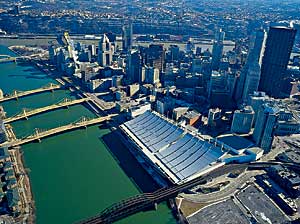A design flaw and the use of the wrong type of steel in Rafael Viñoly’s David L. Lawrence Convention Center, in Pittsburgh, caused a partial collapse there last year, according to a report released this week, as detailed by the Associated Press in an article appearing February 5 on enr.com. A 30-by-60-foot slab of concrete in the loading dock collapsed and fell onto a walkway below in February 2007, as RECORD reported; no one was injured in the incident. “An engineering firm hired to investigate the collapse, Wiss, Janney, Elstner Associates, said a slotted bolt connection used to attach a support beam to an expansion joint was inappropriate given the friction that would develop with temperature changes,” the Associated Press reported this week. “The connection was suitable for light loads, but not the force generated by the expansion and contraction of a large building, said Andrew Osborn, senior principal with the firm. The center’s original design called for steel seats rather than slotted bolt connections, but that was changed.” Steel seats have since been installed on all 50 beams. For its part, Viñoly’s office issued a statement contending that the report vindicates its own role in the project: “Rafael Viñoly Architects was the firm that created the Convention Center’s architectural design; however, it did not engineer the building’s structural steel beams and, more importantly, it was not responsible for the design of the connections between them. The Wiss Janney Elstner report confirms that the cause of the failure was an improperly designed structural connection that was incorrectly installed. The report also makes it clear that the design and detailing of this connection was the responsibility of ADF International Inc., the project’s steel fabricator, and that the connection was built and installed by Dick Corporation, another member of the construction team.” Even so, the city and county’s Sports & Exhibition Authority continues to seek nearly $2 million in damages from Viñoly as well as ADF and its subcontractors, the Pittsburgh Post-Gazette reported on February 6.
![]()
Listen to a podcast of these headlines and more.
Click the play button to begin | Click here to download

Photo © Román Viñoly
Rafael Viñoly’s David L. Lawrence Convention Center, in Pittsburgh, which experience a partial collapse in February 2007.
Los Angeles is readying itself for next week’s opening of the first phase of Renzo Piano’s revamped Los Angeles County Museum of Art (LACMA)—a project more than seven years in the making, albeit with different architects. When LACMA first contemplated remaking its motley assortment of buildings, which include the original 1965 structure by William Pereira and later revisions by Hardy Holzman Pfeiffer, among others, it went with Rem Koolhaas. “He would raze four of the five plaza buildings and replace them with a single huge structure raised on concrete stilts and topped by a billowing, tent-like roof made of Mylar skin and steel bones,” according to a February 3 article in the Los Angeles Times. But in the wake of the recession of 2001, the museum nixed this plan over concerns about its estimated $300 million price tag. Trustee Eli Broad, though he was said to “swoon” over Koolhaas’s scheme, instead approached Piano, who designed a more financially manageable transformation—funded through $200 million of municipal bonds—that sets out to unify the existing structures with new circulation elements. Piano also added a new gallery building, the 60,000-square-foot Broad Contemporary Art Museum, which includes a new main entrance to the entire complex. The boxy, travertine-clad structure is defined by a grand entry stair as well as a jagged roofline of fins that block harsh southern light. “Piano’s attempts to add color and a sense of energy to the exterior of the box with a scaffold of escalators and stairs, which he collectively calls ‘the spider,’ suggest that he is looking back to his professional youth, specifically to the Pompidou Center in Paris,” the Los Angeles Times wrote on February 7. A second phase of construction, which should get underway soon, will renovate a former department store building and join it to the LACMA complex. While Piano’s overall scheme is receiving favorable reviews, Bloomberg’s James S. Russell hinted on February 6 that more than a few observers are suffering from Piano fatigue. The Italian architect produced early masterworks such as the Menil, in Houston, Russell wrote, but “too many risk-averse boards run to Renzo asking him to recycle these masterpieces for them. They are shortchanging themselves and their collections.”
Frank Gehry’s Santa Monica Place mall has been shuttered in preparation for a transformation that will remove the roof from this 1980-vintage shopping complex in Santa Monica, California, to create an open-air passage. The redesign, by the Jon Jerde Partnership—which, ironically, competed against Gehry for the original building commission awarded by The Rouse Company—also calls for “widening the corridors; replacing the dark, cluttered courtyard with a larger elliptical space; and bringing in more upscale tenants,” The New York Times reported on February 6. Despite these changes, the mall will remain at roughly 550,000 square feet when it reopens in late 2009. Macerich, the property’s current owner, had originally planned on completely redeveloping it with a series of high-rise office buildings but dropped this scheme after community opposition. Macerich did not disclose to the Times how much it will pay. The mall was extensively remodeled in 1990—which perhaps means that Gehry is unlikely to mind about the current work. “This was a client-conceived building,” Jon A. Jerde told the Times. And it wouldn’t be the first Gehry project to face the wrecking ball. In early 2007, the University of California, Irvine, razed one of his buildings—a computer science center—to make way for a new engineering complex, the San Diego Union-Tribune reported at the time.

Post a comment to this article
Report Abusive Comment